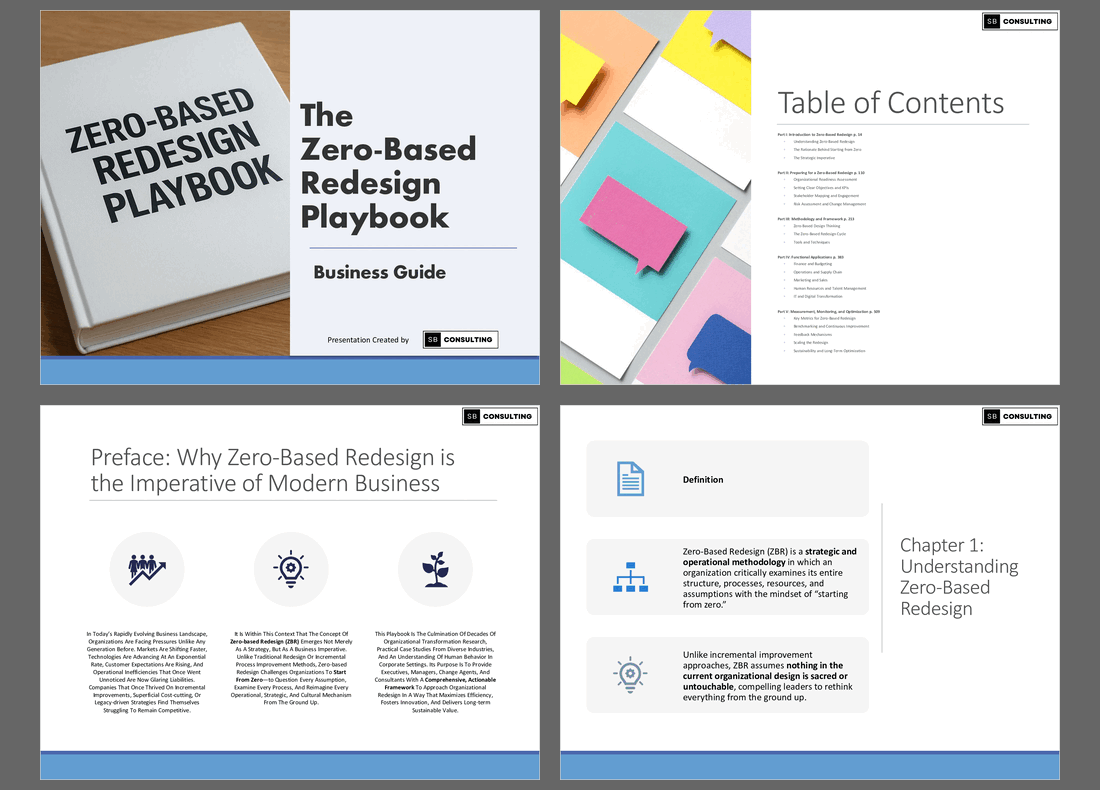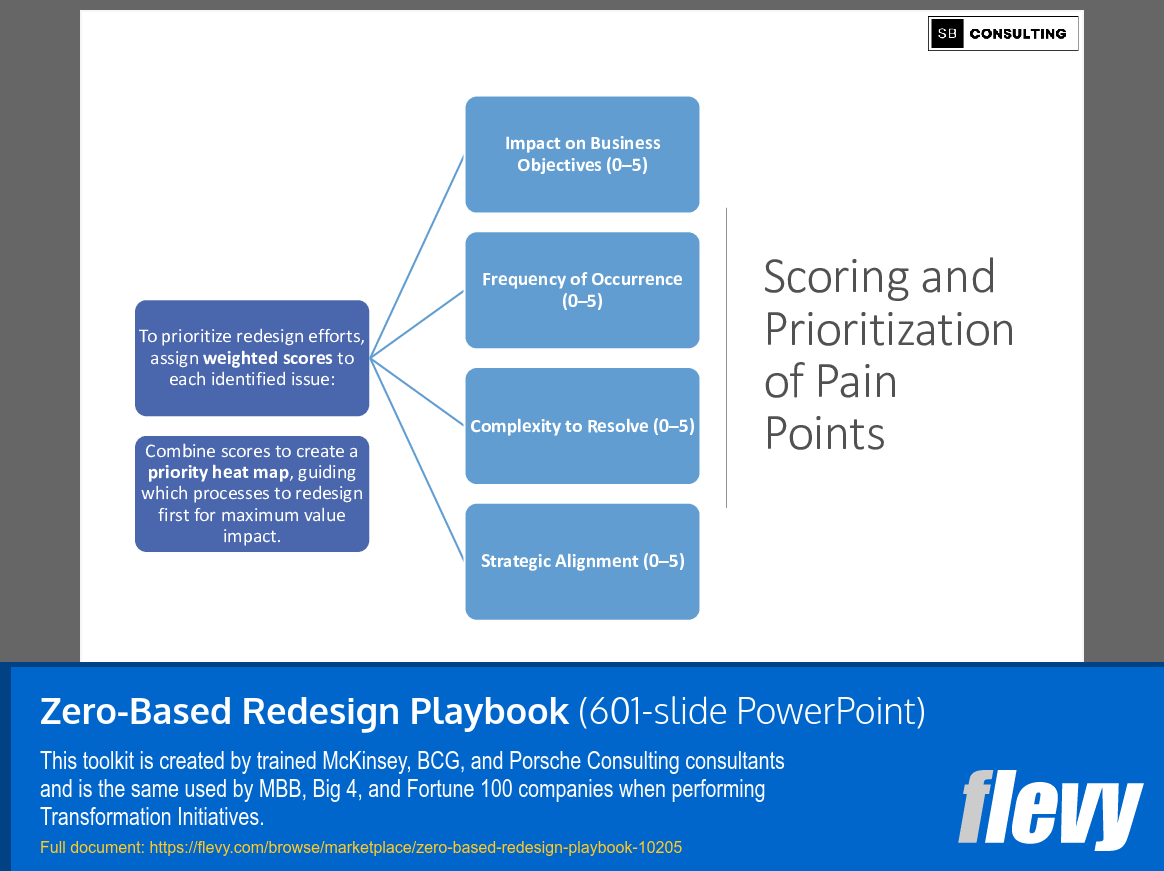Zero-Based Redesign Playbook (PowerPoint PPTX Slide Deck)
PowerPoint (PPTX) 601 Slides
BENEFITS OF THIS POWERPOINT DOCUMENT
- Provides a step-by-step framework for executing a Zero-Based Redesign across all business functions.
- Offers practical tools and methodologies to optimize processes, reduce costs, and boost operational efficiency.
- Enables leaders to align strategy, technology, and culture for sustainable organizational transformation.
COST REDUCTION ASSESSMENT PPT DESCRIPTION
Curated by McKinsey-trained Executives
Unlock the Ultimate Transformation with the Zero-Based Redesign Playbook – Your Complete Guide to Reimagining Business from the Ground Up
Are you ready to revolutionize your organization and achieve breakthrough efficiency, innovation, and growth? The Zero-Based Redesign Playbook is a comprehensive, 500+ slide PowerPoint deck designed to empower leaders, managers, and transformation teams to completely rethink processes, strategies, and operations from zero. Forget incremental tweaks – it's time to break free from legacy systems and outdated workflows, and embrace a systematic, zero-based approach that delivers measurable results.
Why Zero-Based Redesign Is the Future of Organizational Transformation
Modern businesses can no longer afford to patch outdated processes or rely solely on incremental improvement. Zero-based redesign is about starting fresh – analyzing every process, every workflow, and every cost from the ground up. This approach drives strategic clarity, operational efficiency, and innovation at every level. By leveraging the principles in this playbook, your organization can uncover hidden opportunities, eliminate inefficiencies, and design processes that scale with agility.
Comprehensive, Practical, and Actionable
This playbook doesn't just theorize – it delivers practical, step-by-step guidance for executing transformational change. From assessing organizational readiness to mapping key stakeholders, defining KPIs, and implementing risk-aware change management strategies, every aspect of a zero-based redesign is covered. You'll gain tools, techniques, and methodologies to map current processes, ideate smarter solutions, pilot new workflows, and continuously optimize results.
Transform Every Function Across Your Organization
Whether you're leading finance, operations, marketing, HR, or IT, the Zero-Based Redesign Playbook provides tailored guidance to maximize impact:
• Finance & Budgeting: Align spending with strategic priorities, optimize resource allocation, and drive cost-to-value efficiency.
• Operations & Supply Chain: Streamline workflows, leverage automation, and enhance operational agility.
• Marketing & Sales: Reimagine customer journeys, optimize campaigns, and boost sales performance with data-driven strategies.
• Human Resources & Talent Management: Redefine organizational structure, strengthen culture, and enhance workforce agility.
• IT & Digital Transformation: Modernize legacy systems, integrate AI and cloud technologies, and secure digital-first processes.
Data-Driven, Measurable Results
Every recommendation in this playbook is backed by metrics and analytics. You'll learn how to track process efficiency, financial impact, customer satisfaction, and employee engagement. With real-time dashboards, benchmarking tools, and feedback loops, your redesign initiatives are continuously optimized for maximum ROI.
Gain a Competitive Edge and Drive Strategic Growth
Organizations that adopt zero-based redesign don't just cut costs – they innovate, differentiate, and future-proof their operations. This playbook empowers your team to capture new opportunities, respond to market disruptions, and align every process with your corporate vision. It's the ultimate resource for executives, transformation leaders, and managers committed to strategic, long-term success.
CONTENT OVERVIEW
Part I: Introduction to Zero-Based Redesign
1. Understanding Zero-Based Redesign
• Definition and Core Principles
• Difference Between Zero-Based Redesign, Business Process Reengineering, and Lean Transformations
• Key Drivers for Adoption in Modern Organizations
• Cost Optimization and Efficiency
• Innovation Acceleration
• Digital Transformation Enablement
• Strategic vs Operational Applications
• Common Misconceptions About Zero-Based Approaches
2. The Rationale Behind Starting from Zero
• Overcoming Incrementalism
• Identifying Organizational Blind Spots
• Why Legacy Systems and Processes Fail
• The Psychology of "Zero-Based Thinking"
• Cognitive Biases in Business Decision-Making
• Unlearning Legacy Practices
• Quantifying Opportunity Costs of Not Redesigning
3. The Strategic Imperative
• Aligning Redesign with Corporate Vision and Mission
• Risk Mitigation vs. Opportunity Capture
• Quantifying the Value of a Zero-Based Approach
• How Zero-Based Redesign Drives Innovation
• Impact on Stakeholders: Employees, Customers, Investors
• Competitive Differentiation Through Zero-Based Strategies
________________________________________
Part II: Preparing for a Zero-Based Redesign
4. Organizational Readiness Assessment
• Evaluating Current Processes and Workflows
• Identifying Pain Points, Bottlenecks, and Redundancies
• Cultural Readiness for Change
• Leadership and Governance Readiness
• Benchmarking Against Industry Best Practices
• Maturity Models for Organizational Readiness
5. Setting Clear Objectives and KPIs
• Defining Success in Redesign Initiatives
• Operational, Financial, and Strategic Metrics
• Aligning KPIs with Long-Term Goals
• Building a Balanced Scorecard for Zero-Based Redesign
• Linking KPIs to Incentive and Reward Structures
6. Stakeholder Mapping and Engagement
• Identifying Key Stakeholders
• Understanding Stakeholder Interests, Concerns, and Power Dynamics
• Communication Strategies for Buy-In
• Building a Coalition of Change Agents
• Stakeholder Influence and Resistance Matrix
7. Risk Assessment and Change Management
• Identifying Organizational Risks
• Tools for Risk Quantification and Prioritization
• Scenario Planning and Contingency Strategies
• Change Management Frameworks and Methodologies
• Communication Planning for Risk Mitigation
• Employee Adoption Strategies
________________________________________
Part III: Methodology and Framework
8. Zero-Based Design Thinking
• Principles of Design Thinking Applied to Redesign
• Human-Centered vs Process-Centered Approaches
• Mapping the Current State: Journey Maps, Flow Diagrams, Process Blueprints
• Ideation and Solution Exploration
• Rapid Prototyping and Pilot Testing
• Aligning Solutions with Strategic Objectives
9. The Zero-Based Redesign Cycle
Phase 1: Discovery
• Data Collection and Process Analysis
• Stakeholder Interviews and Workshops
• Root Cause Analysis and Value Stream Mapping
• Identifying Non-Value-Adding Activities
Phase 2: Conceptualization
• Scenario Modeling and Simulation
• Alternative Process Design Options
• Technology Leverage and Automation Opportunities
• Cost-Benefit and Feasibility Analysis
Phase 3: Implementation
• Roadmap Development and Prioritization
• Pilot Programs and Iterative Rollouts
• Change Management in Action
• Training and Capability Building
• Communication and Feedback Channels
Phase 4: Continuous Optimization
• Feedback Loops and Continuous Learning
• Measurement and Adjustment of Processes
• Scaling Best Practices Across Teams and Units
• Institutionalizing Redesign Principles
10. Tools and Techniques
• Lean, Six Sigma, and Agile Synergies
• Process Mining Tools and Analytics Platforms
• Simulation and Modeling Software
• Data Analytics for Decision-Making
• Collaboration Platforms for Cross-Functional Teams
• Workflow Automation and RPA Integration
________________________________________
Part IV: Functional Applications
11. Finance and Budgeting
• Zero-Based Budgeting vs Redesign Budgeting
• Resource Allocation Based on Value Creation
• Cost-to-Serve and Activity-Based Costing Analysis
• Aligning Budgets to Strategic Priorities
• Budget Scenario Planning
12. Operations and Supply Chain
• Streamlining Supply Chains from Zero
• Inventory Optimization and Demand Planning
• Process Reengineering for Efficiency
• Leveraging Technology: IoT, AI, Automation
• Supplier Collaboration and Risk Management
• Continuous Improvement of Operational Workflows
13. Marketing and Sales
• Customer Journey Redesign
• Data-Driven Market Segmentation
• Zero-Based Campaign Planning
• Sales Process Re-Engineering
• Customer-Centric KPIs and Performance Metrics
• Feedback-Driven Marketing Optimization
14. Human Resources and Talent Management
• Organizational Structure Optimization
• Talent Assessment and Role Redefinition
• Learning and Development Strategies
• Change Leadership and Culture Transformation
• Employee Engagement Metrics and Retention Strategies
• Workforce Planning for Agility
15. IT and Digital Transformation
• Evaluating Legacy Systems
• Designing Digital-First Processes
• Cloud and SaaS Integration
• Cybersecurity Considerations
• AI-Driven Decision Support and Automation
• IT Governance and Architecture Alignment
________________________________________
Part V: Measurement, Monitoring, and Optimization
16. Key Metrics for Zero-Based Redesign
• Process Efficiency Metrics
• Financial Impact Metrics
• Employee Engagement and Adoption Metrics
• Customer Satisfaction and Experience Metrics
• Leading vs Lagging Indicators
17. Benchmarking and Continuous Improvement
• Internal Benchmarking vs External Benchmarking
• Lessons from Industry Leaders
• Implementing Continuous Improvement Loops
• Adopting Best Practices Across Units
18. Feedback Mechanisms
• Real-Time Analytics and Dashboards
• Regular Stakeholder Reviews and Reporting
• Employee and Customer Feedback Loops
• Iterative Adjustments Based on Insights
19. Scaling the Redesign
• Pilots to Enterprise-Wide Rollout
• Cross-Departmental Integration and Collaboration
• Global vs Local Considerations
• Maintaining Agility During Growth
20. Sustainability and Long-Term Optimization
• Embedding Continuous Improvement Culture
• Leveraging Data for Predictive Decision-Making
• Aligning Redesign with Strategic Resilience
• Institutionalizing Zero-Based Thinking
Why You Need the Zero-Based Redesign Playbook Today
• Overcome organizational blind spots and legacy thinking
• Achieve measurable efficiency gains and cost optimization
• Unlock innovation and digital transformation potential
• Align operations and strategy with corporate goals
Establish a culture of continuous improvement and zero-based thinking
Don't settle for incremental change. Drive bold, measurable transformation across every function in your organization with the Zero-Based Redesign Playbook – the ultimate blueprint for modern business success.
Key Words:
Strategy & Transformation, Growth Strategy, Strategic Planning, Strategy Frameworks, Innovation Management, Pricing Strategy, Core Competencies, Strategy Development, Business Transformation, Marketing Plan Development, Product Strategy, Breakout Strategy, Competitive Advantage, Mission, Vision, Values, Strategy Deployment & Execution, Innovation, Vision Statement, Core Competencies Analysis, Corporate Strategy, Product Launch Strategy, BMI, Blue Ocean Strategy, Breakthrough Strategy, Business Model Innovation, Business Strategy Example, Corporate Transformation, Critical Success Factors, Customer Segmentation, Customer Value Proposition, Distinctive Capabilities, Enterprise Performance Management, KPI, Key Performance Indicators, Market Analysis, Market Entry Example, Market Entry Plan, Market Intelligence, Market Research, Market Segmentation, Market Sizing, Marketing, Michael Porter's Value Chain, Organizational Transformation, Performance Management, Performance Measurement, Platform Strategy, Product Go-to-Market Strategy, Reorganization, Restructuring, SWOT, SWOT Analysis, Service 4.0, Service Strategy, Service Transformation, Strategic Analysis, Strategic Plan Example, Strategy Deployment, Strategy Execution, Strategy Frameworks Compilation, Strategy Methodologies, Strategy Report Example, Value Chain, Value Chain Analysis, Value Innovation, Value Proposition, Vision Statement, Corporate Strategy, Business Development, Busienss plan pdf, business plan, PDF, Biusiness Plan DOC, Bisiness Plan Template, PPT, Market strategy playbook, strategic market planning, competitive analysis tools, market segmentation frameworks, growth strategy templates, product positioning strategy, market execution toolkit, strategic alignment playbook, KPI and OKR frameworks, business growth strategy guide, cross-functional strategy templates, market risk management, market strategy PowerPoint dec, guide, ebook, e-book ,McKinsey Change Playbook, Organizational change management toolkit, Change management frameworks 2025, Influence model for change, Change leadership strategies, Behavioral change in organizations, Change management PowerPoint templates, Transformational leadership in change, supply chain KPIs, supply chain KPI toolkit, supply chain PowerPoint template, logistics KPIs, procurement KPIs, inventory management KPIs, supply chain performance metrics, manufacturing KPIs, supply chain dashboard, supply chain strategy KPIs, reverse logistics KPIs, sustainability KPIs in supply chain, financial supply chain KPIs, warehouse KPIs, digital supply chain KPIs, 1200 KPIs, supply chain scorecard, KPI examples, supply chain templates, Corporate Finance SOPs, Finance SOP Excel Template, CFO Toolkit, Finance Department Procedures, Financial Planning SOPs, Treasury SOPs, Accounts Payable SOPs, Accounts Receivable SOPs, General Ledger SOPs, Accounting Policies Template, Internal Controls SOPs, Finance Process Standardization, Finance Operating Procedures, Finance Department Excel Template, FP&A Process Documentation, Corporate Finance Template, Finance SOP Toolkit, CFO Process Templates, Accounting SOP Package, Tax Compliance SOPs, Financial Risk Management Procedures.
NOTE: Our digital products are sold on an "as is" basis, making returns and refunds unavailable post-download. Please preview and inquire before purchasing. Please contact us before purchasing if you have any questions! This policy aligns with the standard Flevy Terms of Usage.
Got a question about the product? Email us at support@flevy.com or ask the author directly by using the "Ask the Author a Question" form. If you cannot view the preview above this document description, go here to view the large preview instead.
Source: Best Practices in Cost Reduction Assessment PowerPoint Slides: Zero-Based Redesign Playbook PowerPoint (PPTX) Presentation Slide Deck, SB Consulting









